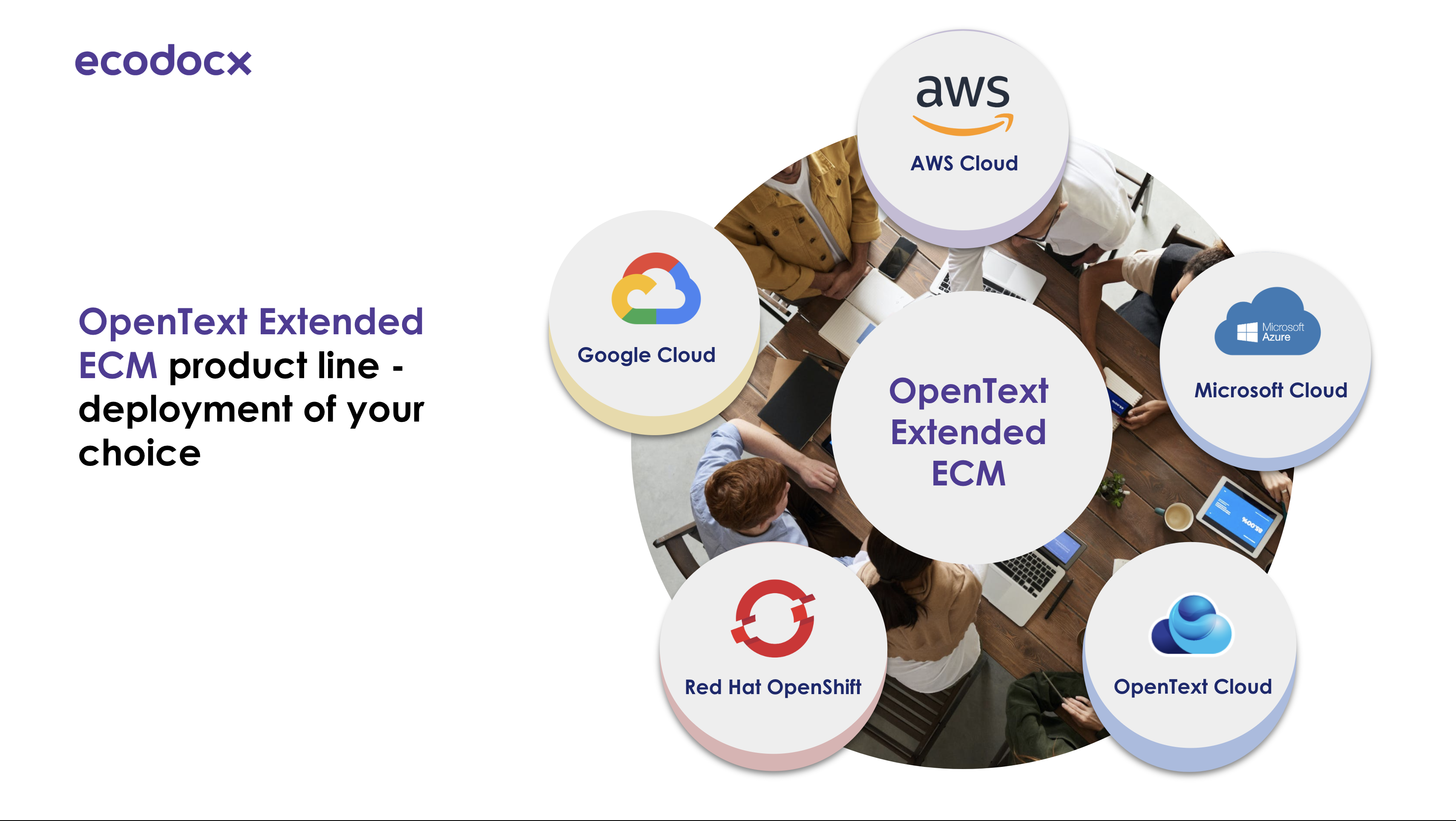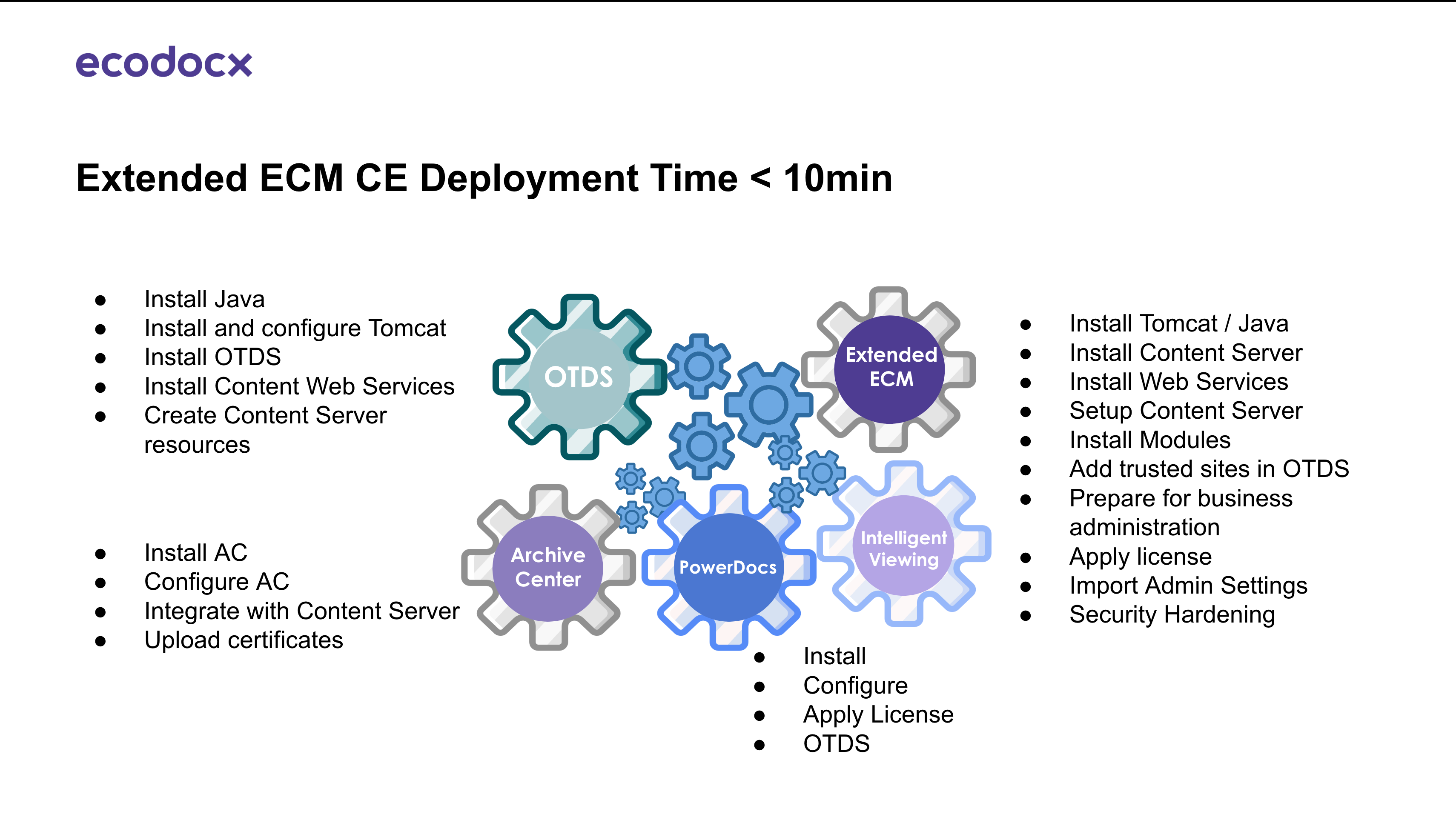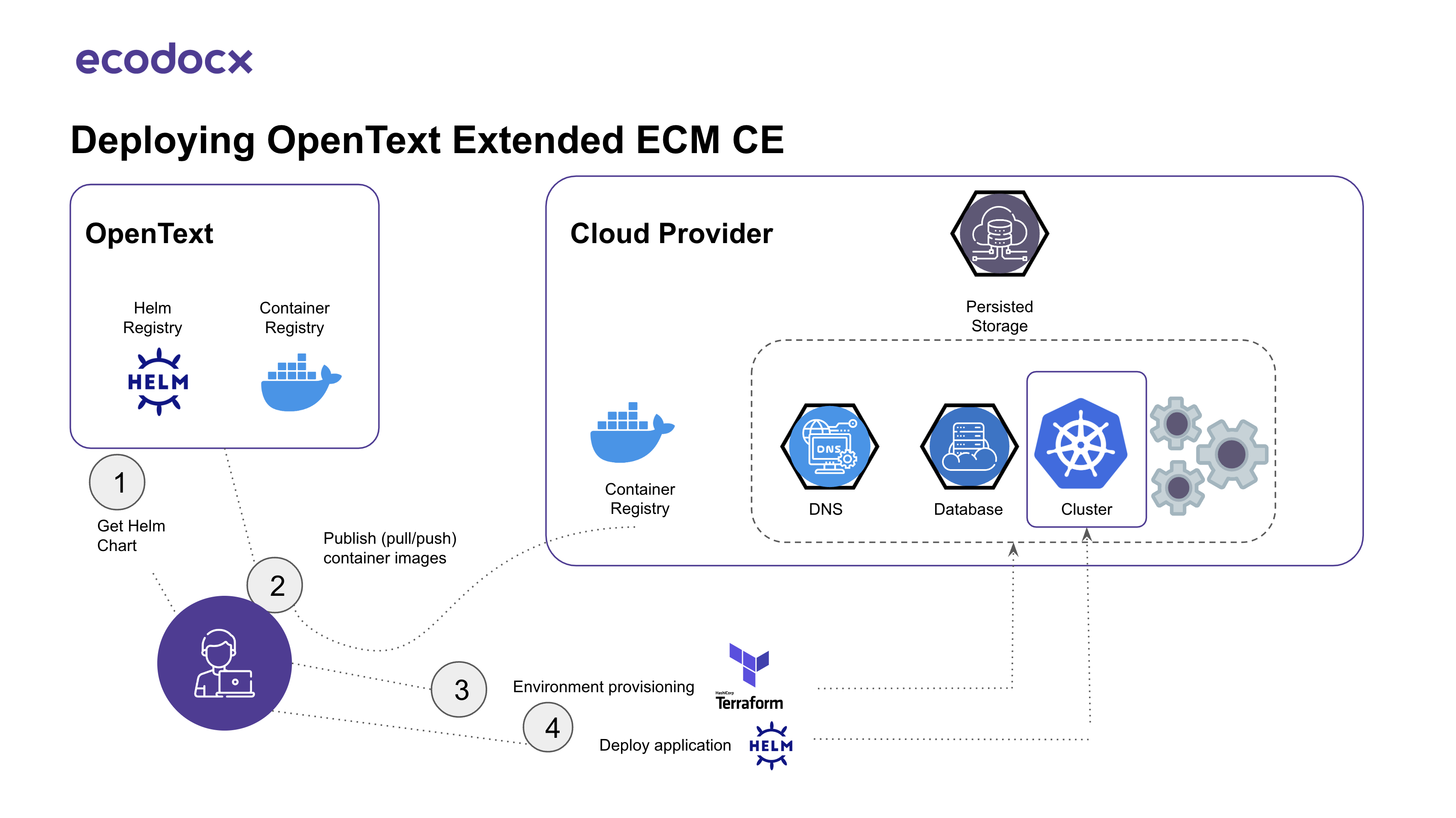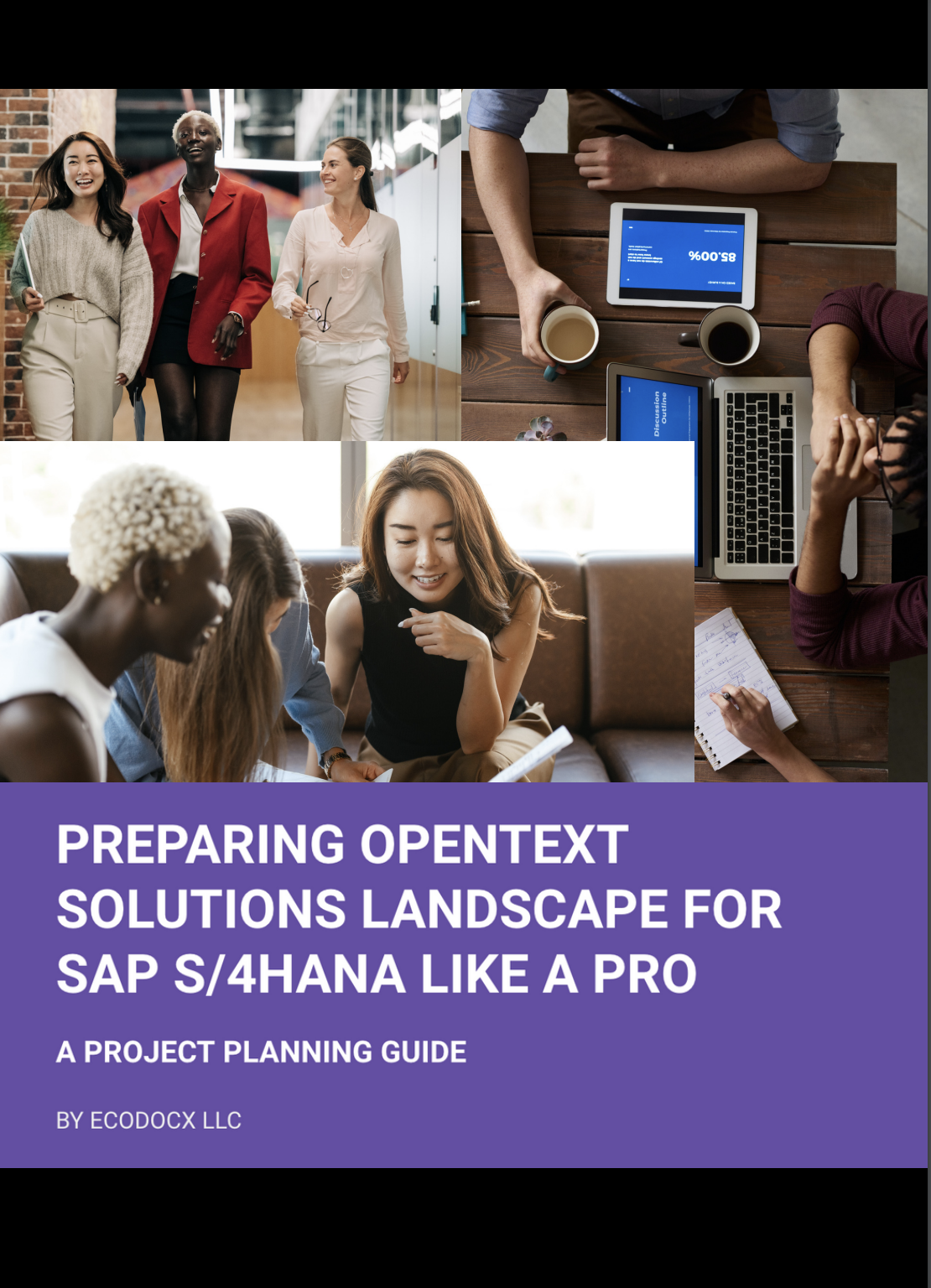In this blog post, you will learn how the OpenText Extended ECM product line connects content to digital businesses to accelerate productivity, improve governance, and drive digital transformation and automation.
The Extended ECM line includes the following solution packages: Extended ECM Platform & Content Suite, Extended ECM Documentum for SAP & Salesforce, Extended ECM for Salesforce, SAP & Office 365, Extended ECM for Engineering, Extended ECM for SuccessFactors, Extended ECM for Government. All these packages come as docker images for cloud deployment to support customers on their way to process automation.

How is OpenText Extended ECM Cloud Edition driving automation?
Why is automation so important and should IT admins out there care? Let us give you some key aspects of that:
First, of course, is time to market. You want to make sure that your solution is deployed in an efficient way as soon as possible. Automation is really critical for that. Even if you have VMS automation may take several days or even weeks, right? So OpenText containerized the CE packages to enable their customer to deploy automation in minutes.
Continued upgrades are another aspect of why automation is important. Once you deploy your solution, you would like to make sure it’s updated regularly. CE solutions support quarterly and monthly update releases and allow customers to stay on top of innovations, and security, enabling customers to maintain their competitive edge.
Scale and customize dynamically: Another important aspect is scale dynamically. CE encourages companies to grow, by maximizing utilization and minimizing costs. Let’s say your business grows, you get more contracts and you need to leverage your resources due to growing demand in your environment. Automation can help here. You can scale and customize your environments with confidence without breaking the deployment and automation.
Deploy anywhere: CE supports on-premise and cloud deployments (e.g. OpenText Cloud, AWS, Azure cloud, Google cloud, Red Hat Openshift, etc).
What are Kubernetes in Extended ECM?
Kubernetes is an open-source platform that is responsible for deploying and orchestrating the containers that OpenText delivers as part of its Cloud Edition (CE) product offering. Kubernetes can do the following for you: schedule deploying and define where containers should run, scale deployments up and down, discover where containers are running, distribute load with load balancers, provide storage to containers with persistent volumes, as well as log and track what is happening with all containers at all times.

What is included in Extended ECM CE?
As we mentioned above, Kubernetes are an important part of Extended ECM CE, but what are the artifacts needed to deploy Kubernetes?
- Docker Images: OpenText delivers the OpenText Extended ECM product line as docker images by packaging Extended ECM as “cloud-native” applications
- Automation: To ensure that your solutions are “customer-ready” out of the box in minutes
- Helm Charts: Provide the configuration “recipe” for Kubernetes-based deployments. Here you define how you want to deploy your solution and all the details of that. When you deploy your applications you have multiple components. You want to make sure that all the components are talking to each other and are properly configured. In the image below you can see an example of what a helm chart looks like. We have an image, for instance, the Extended ECM. You can define the tag, in this case, the version that you want to deploy. You can also define the resources like CPU or memory needed. The great benefit here is that you can grow. You can start small and once needed you can grow. For many companies, it’s very important to reduce costs and save some resources while scaling. You can define the number of replicas. You can start with one front end, and down the road go and just increase the number as needed.
The below aspects are involved in an Extended ECM deployment. The docker containers provided by OpenText deliver automation. With automation, we can deploy all the components out of the box in less than 10 min. Imagine if you would have to deploy all of these components manually. You would need to install, configure and integrate these components with each other. This process would take anything from several days to weeks. With the xECM containers, you can benefit from all of these configurations coming out of the box. This technology has been improved over the last three years by OpenText to make deployments as smooth, secure, and secure as possible.

The below chart shows what is happening behind the scenes when Extended ECM docker containers are deployed for the first time. Everything starts with retrieving the helm charts in the containers from the Extended ECM registry. Users access helm charts on their machine, pull helm images from OpenText, and push through their cloud provider of preference (or just access the container registry in case they decided to go with the OpenText cloud). The next step would be to provision the environment (in this example by using the tool Terraform). You need to define the database that you want to connect to, cubert clusters, the DNS and some other things. The Terraform can help provision all these environments before you start deploying, so everything can de automated end-to-end. Once everything is set up using the help charts.
You might ask yourself “okay but what would a version upgrade look like”? Imagine there is a new version of Extended ECM available and OpenText released a new version of the helm charts and the respective containers. The admin will get the help charts. The new environments would be already provisioned. The admin would just need to push the images to the container registry of preference, and deploy new help charts on existing environments. So, any time OpenText releases an update, the admin just needs to retrieve the helm, apply a patch upgrade, and deploy on the existing environment. All your images will be automatically updated. This approach streamlines the process to deploy and upgrade solutions in a much faster, more secure, and more reliable way because there is minimum manual interaction.

Customizing Extended ECM CE
If you need to do any customizations to your Extended ECM CE implementation, the helm charts are the place for that. You have all the capabilities to ingest custom settings. You might ask yourself “but containers are immutable, how can we customize the containers?”. OpenText has a framework for that. Starting with the release 22.x you have the ability to ingest extensions using init containers. This is a subset of containers that you can use on top of Extended ECM CE app containers to add modules, language packs or other enhancements. This can be part of the automated deployment.
Wrap-up & Advice
For IT administrators, embracing automation with OpenText Extended ECM Cloud Edition can yield several benefits. Firstly, it enables faster deployment of solutions, reducing the time required compared to manual processes. Secondly, automation simplifies the process of maintaining and upgrading solutions, ensuring organizations can leverage the latest features and security enhancements promptly. Moreover, the scalability and customization capabilities empower businesses to adapt to changing demands seamlessly. By utilizing Kubernetes, IT administrators can efficiently orchestrate and manage containers, optimizing resource utilization and enhancing overall operational efficiency. Finally, taking advantage of the customization options available through helm charts allows organizations to tailor Extended ECM CE implementations to their specific needs, further enhancing the value derived from the solution.
In conclusion, OpenText Extended ECM Cloud Edition, driven by automation and Kubernetes orchestration, provides organizations with a powerful toolset to accelerate productivity, improve governance, and drive digital transformation. IT administrators are encouraged to explore and leverage the automation capabilities offered by Extended ECM CE to streamline deployments, enhance agility, and optimize their content management processes.
By working with a trusted service provider, who has strong expertise in OpenText Extended ECM, you can transform a wide range of document-related processes at your organization. Interested in finding out more? Check out our OpenText Extended ECM services page, or schedule a session with one of our experts.
